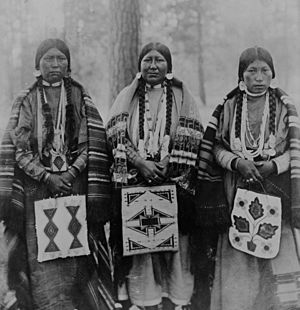Confederated Tribes of Warm Springs facts for kids

Three women photographed on the Warm Springs reservation in 1902.
|
|
| Regions with significant populations | |
|---|---|
The Confederated Tribes of Warm Springs is a group of three Native American tribes who joined together. They live and govern themselves on the Warm Springs Indian Reservation in Oregon, USA.
Meet the Tribes
This group is made up of three main tribes from the Pacific Northwest region:
- The Tenino people, who speak a language called Sahaptin. They have four smaller groups: the Upper and Lower Deschutes (also known as the Tygh and Wyam), the Dalles Tenino, and the Dock-Spus (John Day).
- The Wasco Indians, who spoke a type of Chinook language. Their groups included The Dalles (also called Ki-gal-twal-la) and Dog River.
- The Northern Paiutes, whose language is part of the Uto-Aztecan language family. This language is similar to Shoshonean.
The Wasco Tribe
Wasco Language: Kiksht
The Wasco language, called Kiksht, has been passed down through many generations of Warm Springs Tribe members. People are working hard to save this old language through special classes and recordings.
A long time ago, from 1790 to 1920, the United States government had a policy to make Native Americans live like other Americans. This policy almost made the Kiksht language disappear. Young tribe members who went to government schools were only allowed to speak English. They were not allowed to speak their native language.
In 2012, the last person who spoke Kiksht perfectly, Gladys Thompson, passed away. This made the language almost extinct. To help save it, Central Oregon Community College offers a class in the Kiksht language. The teacher, Ms. Valerie Switzler, even won an award in 2016 for her work in community linguistics. There are also recordings of Kiksht conversations saved at the Endangered Languages Archive in London.
The Warm Springs Tribe
Warm Springs Groups
The Warm Springs tribe is made of different groups, even though they live in different places. These groups include the Tenino, the Lower Deschutes (also called Wyam), the John-Day (or Dock-Spus), and the Upper Deschutes (or Tygh).
Warm Springs Language
The Warm Springs tribe spoke a language called Sahaptin. Today, only about 50 people can speak it fluently, and all of them are over fifty years old.
The Paiute Tribe
Paiute History
The Northern Paiutes used to live in a very large area. This included southeastern Oregon, southern Idaho, northern and southern Nevada, northern California, and parts of Montana and Utah.
Paiute Language
The Northern Paiutes speak an Uto-Aztecan language called Numu. In 1999, about 1600 people spoke Numu. It is closely related to the Mono language.
History of the Confederated Tribes
Early Life and Culture
Before they became the Confederated Tribes of Warm Springs, the Wasco, Warm Springs, and Paiute tribes lived near the Columbia River and the Cascade Mountains. Each tribe had its own language and traditions.
The Warm Springs and Wasco tribes often traded goods and talked with each other. However, the Paiute language was very different from the others. This made it harder for the Paiute people to communicate often with the other tribes.
Arrival of Settlers
In the 1800s, people from the eastern United States began to arrive in the West. By 1852, about 12,000 settlers crossed the tribes' lands each year. This disrupted the traditional ways of life for the tribes.
In 1855, the Warm Springs and Wasco tribes signed a treaty with Joel Palmer. By signing this treaty, the Wasco and Warm Springs tribes gave up 10 million acres of their land to the United States. In return, they kept 640,000 acres for their own use.
The first Paiute people to move to the Warm Springs Reservation were 38 individuals. They were forced to move there from the Yakama Reservation in 1879. Soon, more Paiutes arrived, and they eventually became a permanent part of the Warm Springs Reservation.
Forming the Confederation
The Confederated Tribes officially adopted a constitution in 1938. This happened after the Bonneville Dam was built, which flooded a very important fishing spot called Cascades Rapids.
Later, in 1957, the construction of The Dalles Dam flooded another major fishing site, Celilo Falls. The Tribes received $4 million as payment for this loss. They used some of this money to build the Kah-Nee-Ta resort, which opened in 1964.
Taking Political Action
In 2001, members of the Confederated Tribes convinced the Oregon Legislative Assembly to pass a new law. This law required that the word squaw be changed in many place names across Oregon.
Images for kids


